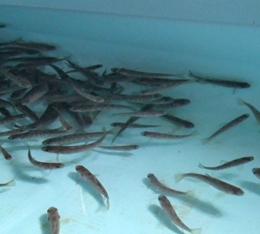Posted March 17, 2022 at 10:36am by Anonymous (not verified)
Brown trout thrive on Mountain Foot Farm

On a sunny spring day earlier this year, steam was pouring out of sugarhouses, calves and lambs and kids were being born, and greenhouses were teeming with plant starts. And on Curtis Sjolander’s Mountain Foot Farm in Wheelock, in the barn just behind his house, hundreds of brown trout were swimming in their large tanks, slowly growing in cold waters until they could be sold to Vermont restaurants and customers at the St. Johnsbury farmers’ market.
The Sjolanders (Curtis and his wife Joan, who’s a nurse by profession) started farming vegetables in the 1980s, but a quirk of weather brought surprise one year—and with it, an opportunity.
As Curtis describes it, “It was 1988, a drought year, and our spring stopped running. [The family relies on the spring for all of their water needs.] So it was a good time to find another, and we went looking farther up the mountain, and we found a great one. It was flowing 30 gallons a minute, and it got us through that dry summer. So I tried to think of another use for it. My father had seen an episode of UVM’s ‘Across the Fence’ about another fish farm and he thought I should do that, too. So we went to talk to the woman who ran it about aquaculture.”
Soon after, Curtis added fish to his farm, although he kept on with his career in computer programming (“to fund my farming habit,” he laughs). He put 100 fish in an outdoor pond and 100 in a tank in a shed. “I figured we’d see what would happen.” Every day, he’d go to feed and check on the fish, as any farmer would check on their livestock, but then one day he noticed there were a couple of fish missing from the pond. And then there were a few more missing, and he suspected something odd was going on. “You learn how to tell when something’s spooking them,” he says, “from their behavior when they’re fed.”
Then one day that winter he went to the pond and did a double-take: the pond was completely empty of fish. He talked to neighbors and farmers and they said that a common winter behavior of minks is to prey on fish. “They’ll take just a few fish and then when they establish that they’ve found a good supply, they’ll clean you out and put them in snowbanks to stockpile to get through the winter.” Curtis did eventually find two fish left in that pond, hiding inside the tank’s exit pipe.
Curtis began to use his observational skills and habit of careful record keeping to refine his approach. He installed 1,000-gallon tanks and then built a barn around them, learning how to deal with predators and how to balance the work required by both vegetables and fish, taking into account the different seasonal needs of each.
In 2012, Mountain Foot Farm sold more than 3,000 trout. And while that represents many years’ investment of time and resources, Curtis knows it’s well below the level of demand for locally produced fish in Vermont. Although eager chefs and grocery buyers have been clamoring for his product, he has been taking his time to scale up because he sees no reason to compromise on the quality he wants. “I’ve been raising trout for 20 years, but only at this scale for five or six. I needed to take that time to make mistakes and learn,” he explains.
*Excerpted from Cheryl Herrick, "In the Tank: Brown Trout Thrive on a Wheelock Farm," Vermont's Local Banquet, Summer 2013.
